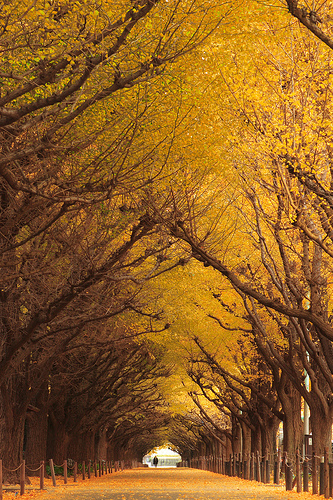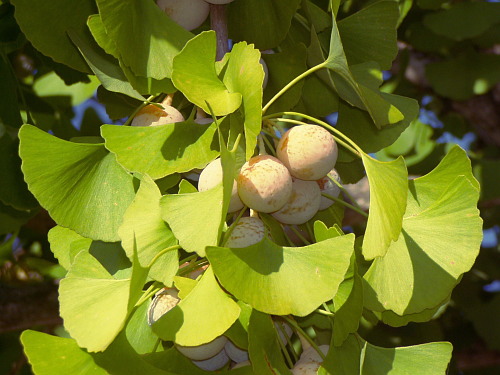Ginkgo biloba (Maidenhair Tree)
Welcome to the site completely dedicated to Ginkgo biloba!

Ginkgo biloba is an incredibly fascinating plant that has
been around for centuries. It is the only species remaining from the
Phylum Ginkgophyta and because of this many call it “the living fossil.”
Some other common names for Ginkgo biloba are the Ginkgo tree,
Kew tree, Fossil tree, and the most common is the Maidenhair tree. It
got this name because it slightly resembles the
Maidenhair Fern.
Ginkgo biloba can
grow up to 120 feet tall and it can live to be about 1,000 years old!
The Ginkgo tree is dioecious, which means that each plant is
either male or female; both reproductive organs are not found on the
same tree. In the fall, most people can recognize the female tree
because of its stench. Some people say the rotting seeds smell like
vomit, while others say they smell more like rancid butter. To avoid the
revolting smell, many city officials plant only the male species of the
tree.
There is good reason to why Ginkgo biloba is planted in
almost every major city across the US. This
is
because the
Ginkgo tree is resistant to so many different things,
like insects,
 fungicides, most pollution, and bacteria!
Ginkgo
biloba also is found to be an extremely beneficial herb for
medicinal purposes, such as prevention of cancer, increasing blood
circulation, reducing cerebral insufficiency and glaucoma, and many
more! Today, increasing amounts of research are being done on Ginkgo biloba
in order to explore all the medicinal values in this magnificent
organism.
fungicides, most pollution, and bacteria!
Ginkgo
biloba also is found to be an extremely beneficial herb for
medicinal purposes, such as prevention of cancer, increasing blood
circulation, reducing cerebral insufficiency and glaucoma, and many
more! Today, increasing amounts of research are being done on Ginkgo biloba
in order to explore all the medicinal values in this magnificent
organism.
To understand where Ginkgo biloba falls in the grand scheme of
organisms, go to FAMILY
TREE!
If you get confused at any time with the vocabulary I am using
throughout the website, feel free to check out the
GLOSSARY!
Ginkgo biloba is only one of many, many creatures on the
planet. My classmates and I are trying to create a website for each
living organism. Please check out some of their amazing species at
MultipleOrganisms.net!
Webpage created by: Brittany
Lehrer
The University of Wisconsin- La Crosse
Last Updated on: April 16, 2011
